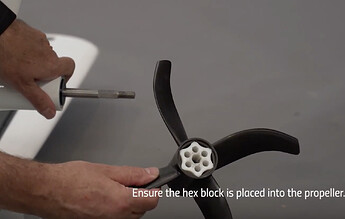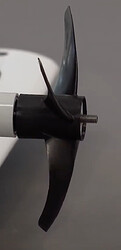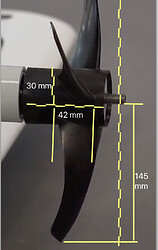These are really thin, superb and really cheap (2.25USD per prop) . 30cm reduced to 25cm why not.
This kit is for a quadricopter (4 arms), 2 motors per arm = 8 propellers = 2.25 USD per propeller
Possible issues:
1 - They look like rotating knife blades:
2 - Stiff for sure but how much for our use : I am not sure they will not bend under load. We are 100kg /2kg = 50 times more heavy. We have to try.
3 - The extremity of the motor axes could be adapted with a kind of T-nut where you can lay those props flat, maybe maintained with an invisible pressing screw hidden behind a nose like @Gobbla pod one…
Not enough pitch Should be 10 at least
I think you missing the point. With a 240mm prop you need 240mm of water to ride in. That’s 10cm more than a 140mm prop. There’s less margin for error, and less margin if you happen to run through shallower water. If you were foiling you’d understand what I’m saying.
I agree with you on that Jezza, you want as much height as possible before the prop starts lifting out of the water and losing thrust. 10cm is a lot too, especially if using a shorter mast.
You don’t need to be an efoiler to foil.
No sensible foiler rides in 240mm of water even with a 140mm prop. If I don’t have chest deep, I don’t kitefoil, I do something else.
I think you are missing that we are trying to write a new page of the sport. To cut amps drawn by a factor of 2 to 3, we have to think differently… :
1 - either adapting the existing gear without reducing the mast length

2 - or introducing new concepts to reduce drag and wet surface. For this, IMHO, the canard is the best platfom for extended flight times since you can use 550cm2 at the mast that will add up in terms of lift to the 250cm2 of the front wing. That’s way better than a 900cm2 front wing in a conventional setup where the 350cm2 stab with negative lift (mounted upside down) will introduce a lot of drag. Yes, a canard might be difficult to ride above 30knots but it is not the target since the setup is OK at 20 and even 25.
A canard is nearly drag-free since both front and rear wing are operating at their optimum lift/drag ratio angle. That’s why Zeeko has met an enormous success since the initial launch and introduced the XLW and XXLW front wings afterwards.

I have had good success using cut-down model aircraft propellers on my efoil, and have qualitatively compared them to traditional wide-blade marine style props. With the same pitch and diameter, I can foil significantly longer using the model airplane props.
The reason traditional boat propellers look different from aircraft propellers is two-fold: structural strength (required for 800x higher density fluid), and control of cavitation. The very wide (low aspect ratio) blades of traditional marine propellers create a lot of unnecessary drag (due to excess surface area), especially at the high speeds and low loads of foiling, which can be greatly reduced with a higher aspect ratio blade, while still maintaining adequate strength and rigidity for our application, and still without cavitation issues. 14 - 18" diameter model propellers (glass reinforced thermoplastic) cut down to 6 - 7.5" diameter are plenty stiff & strong. Pitches ranging from 7 to 12", and 2 & 3 blades have been tested successfully. I am just now hooking up my new e-logger to get quantitative efficiency & speed data.
Theoretically, the narrowest blade (highest aspect ratio) prop of the correct pitch & diameter for the motor, that does not deform or cavitate under maximum lift conditions, will be the most efficient. Two blades should be more efficient than three, however, my experience has been that two blade props have not been quite as smooth, maybe because they are running in the wake of the mast (so the mast wake interference is synchronized to both blades).
Also - I agree, a canard should be the most efficient wing & stabilizer set-up if properly executed!
E-foiling is very different to kite foiling!
You might think you are always in chest deep water, but there’s no guarantee when you can’t see whats under the water. You might be riding much shallower once up on the foil.
I get that you are trying to create something more efficient, but it will come at a price somewhere else.
No matter how you structure the fuselage, the larger the prop, the less height you have, as it will always require the prop to be submerged properly.
As for the canard concept, that brought other complexities in airplane design and as a result was not widely adopted. You might very well find it to be the same hydrofoils…
What is interesting is what the designer of the spitfire foil thinks: For glide and speed a standard foil will win. For carving or free-ride, a canard would be better.
With more and more people enjoying the efficiency of their FR 2 blade folding prop (no duct), I was wondering if sbdy had done some further tests with a high AR APC air style prop ?
Hey @visor360, this is another field where applying your process: 8" diameter blade prop with high AR (8-10" pitch). Airfoil section ? Very thin Eppler 817 + twist ?
Picture credit: S9Tim.
Yes I think it’s possible to do it (not with casting resin but in carbon fiber).
It will be more complicated to design than wings. Because the blade section, size and angle of attack changes from the center to the tip of the blade (as you can see in the picture the blade is much thicker around the center, and very thin at the tip).
So I will need to design a propeller by hand (do the calculation by hand) then make a computer model for CFD analysis (and validate it). Once I have the same result by hand and with CFD, I can optimize the propeller for our need, and finally we can test it in real water.
A nice article about propeller efficiency (key word ETA)
Can someone give me a link for those FR 2 blade folding props?
I can’t find them anywhere on the FR website…
i literally have buckets of 12" and 11" carbon fiber props, will try this out.
Does anyone know anything of the Manta 5 project? Noticed the prop is interesting, perhaps a worthy candidate for an efficiency optimised prop.
From a quick look at the construction video it looks like they’ve gone with a pretty high aspect prop, mix between multirotor and plane style.
Specs from their website: 21kph top speed, 460W pedal assist motor
Complete napkin measurement of the prop gives around 10 inch diameter and 12 inch pitch, which gives around 1200rpm at full speed, so perhaps 4S and 100kv motor. Likely the 12 inch is more like 10 or the top speed is much lower.
Nice looking high AR blades. Could work for a Waydoo / Fliteboard type of fuselage.
A standard LIFT-like efoil fuselage is not running that deep.
The issue will be the torque you need. On the Manta 5 you have a huge amount of torque available whereas with 4S you have very little torque.
torque due to human input at the pedals? Any guesses as to the power train they would use?
Thanks
You can expect ‘standard’ human power, when cycling for instance, around 100-130W and between 170-200W for a short period of time.
The average cyclist can deliver roughly 3 watts of power for every kilogram of their weight for one hour.
A top cyclist can deliver roughly 25 watts of power for every kilogram of his/her weight, but only for short periods of time (before the finish line, etc.).
Any guesses to the motor and battery that they might have used? Prop shaft at a guess is 10mm




